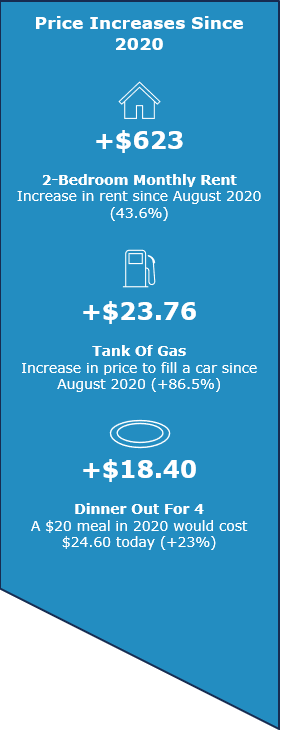Arizona Inflation Update — September 2023
Author: Kamryn Brunner
Introduction
On a year-over-year basis, Consumer Price Index (CPI) inflation in the Phoenix metropolitan area decreased in August to its lowest point since March 2021 (when it was 2.9%). At 3.7%, year-over-year price inflation in the Phoenix metropolitan area is now less than half its reading of 9.0% in January of this year. Between June and August Phoenix area inflation rates decreased 0.7 percentage points (local inflation numbers are published every two months); over the same period the U.S. inflation rate increased from 3.1% to 3.7%.
After 29 consecutive months of running higher than the nation as a whole, the Phoenix metro area now has the same inflation rate as the U.S. While national price increases are again accelerating, official measures of inflation are stabilizing in the Phoenix metro and increases in some prices are being offset by decreases elsewhere. For example, gas prices in our market decreased -2.6% over the past 60 days, while costs of recreation services rose +2.6%. Although year-over-year shelter inflation (+7.5%) remains elevated in the Phoenix area, the rate of growth has decreased 0.7 percentage points since June. If this continues it is likely to put downward pressure on official measures of local prices as CPI surveys of rent catch up with actual market rates (more real-time measures of market rent were already in decline). Services inflation decreased 0.2 percentage points since June but remains significantly higher (+5.2% year-over-year) than inflation in the cost of goods.
Prices in Metro Phoenix increased +0.04% (month-over-month) and +3.7% over the last 12 months (August ’22 through August ’23) – (BLS CPI Survey)
- Since the end of 2020, the typical Arizona household would have had to spend a combined $23,768 more on food, housing, transportation, medical care, and other goods and services to buy the same stuff as they were buying three years ago.
- Because of inflation, today it costs the typical Arizona family over $2,700/year more to purchase the same goods and services as it would have cost in August 2022. Even if the rate of inflation slows, it would take a sustained period of deflation to restore historical price levels.
- Inflation in metro Phoenix over the past 12 months (3.7%) matched the national average of 3.7%.
- For the first time during this period of rapid price increases, the cost of Shelter in the Phoenix area (market and imputed rental prices) decreased between June and August (-0.7%). This is the first recorded decrease in Shelter prices as tracked by the CPI since the series begins in 2018.
- Inflation excluding more volatile food and energy prices (so-called “core inflation”) is at 3.5% in the Phoenix area (slightly lower than overall inflation, again reflecting slowing shelter inflation).
- Of the 23 urban consumer price indices tracked by the BLS in August, the Phoenix metro area had 4th lowest rate of measured inflation (month-over-month) – a steep drop from 2nd highest in April, and again highlighting the volatility local gas and shelter prices have had on the headline measure.
- On a (smoother) year-over-year basis, August prices in the Phoenix area rose at the 10th fastest rate in the country (down from 9th highest in June).
- Although average hourly wages in Arizona have increased 5.4% year-over-year, inflation has increased 3.7% causing a gain in real wages of 1.7% year-over-year. Wages continued their rapid increase, and in August inflation failed to outpace these increases and caused a gain in total wages. However, keeping in mind long-term rising inflation, real wages in Arizona have fallen 9.4% since peaking in April 2020.

